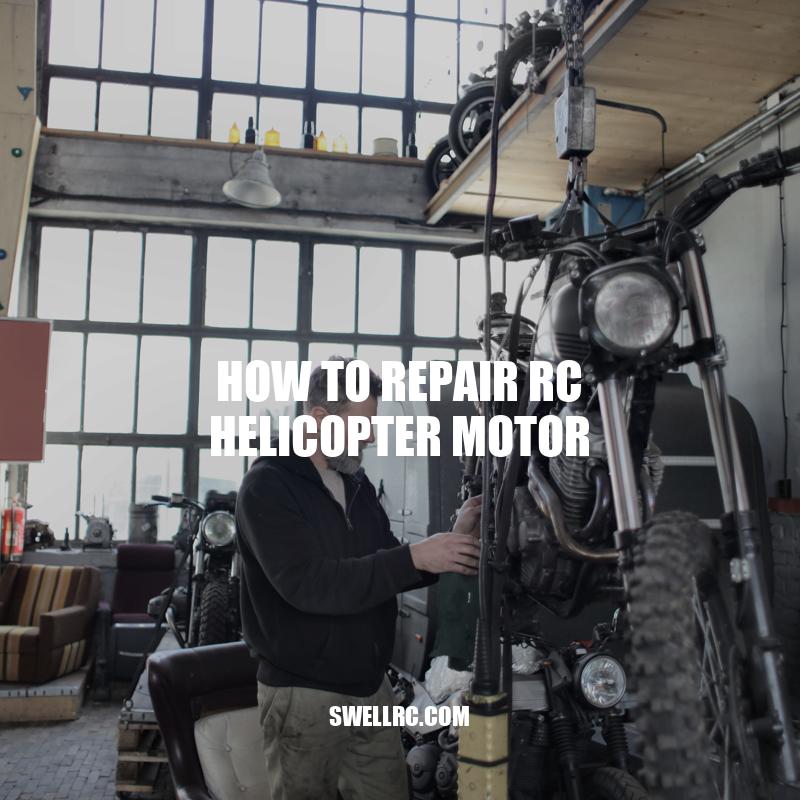DIY Guide: Repairing your RC Helicopter Motor
Remote Control (RC) helicopters have gained popularity among hobbyists and enthusiasts worldwide. RC helicopters come in different sizes and designs providing varying levels of user experience. The motor is an essential component of an RC helicopter, responsible for powering the rotating blades that keep it airborne. Given the significance of the motor for an RC helicopter’s smooth functioning, a malfunctioning motor can be frustrating. Common issues that can lead to motor failure include overheating, friction, or wear and tear from extensive use. While replacing a faulty motor is an option, it can cost a considerable amount of money. Repairing the motor can be a less expensive alternative for those looking to maintain their RC helicopters effectively. In this article, we will provide a step-by-step guide on how to repair an RC helicopter motor, emphasizing the importance of proper disassembly, cleaning, reassembly, and testing. By the end of the article, the reader will have the necessary skills to identify an issue in their RC helicopter’s motor, repair it, and improve their helicopter’s overall performance.
Identifying the Issue
To repair an RC helicopter motor, one must first identify the problem. The following steps will help you identify the issue with your motor:
- Listen for strange noises or vibrations while running the motor
- Observe the movement of the motor and see if it is working correctly
- Inspect the motor for any external signs of damage or wear and tear
- Check if the motor is heating up or creating any smell
After familiarizing yourself with the above, you will be equipped to identify the problem with your RC helicopter motor. If you’re still having difficulties finding the issue or need assistance, you can find helpful tutorials or advice on websites like RCGroups or helifreak.com. These websites have forums for RC enthusiasts where experienced users can offer valuable insights into repairing an RC helicopter motor.
What is the voltage of the RC helicopter motor?
The voltage of an RC helicopter motor can vary depending on the specific model and size of the motor. Some common voltages for RC helicopter motors include:
- 3.7V
- 7.4V
- 11.1V
- 14.8V
- 22.2V
When shopping for an RC helicopter motor, it’s important to check the voltage specifications to ensure compatibility with your specific helicopter model. You can find voltage information in the product description or manual, or by contacting the manufacturer or retailer for assistance.
Disassembling the Motor
Once the issue has been identified, the next step is to disassemble the motor. It is important to take any necessary precautions to prevent any damage that might occur during the process. Here are some steps to guide you through the process:
| Materials needed | Steps to follow |
|---|---|
| A screwdriver or pliers |
|
It is important to be gentle while disassembling the motor to avoid any damage to the motor’s components. It is also worth noting that some RC helicopters have unique disassembly processes, and it is advisable to check their respective manuals. Websites like RCGroups or FliteTest have video tutorials that might help with disassembling the motor correctly.
What is the procedure in disassembling an electric motor?
To disassemble an electric motor, follow these steps:
- Disconnect the power source and disassemble the housing of the motor
- Remove the bolts and screws that hold the end bells to the stator
- Slide the rotor out of the stator
- Remove the end bells and bearings from the stator
- Clean and inspect all parts for any damage or wear
It is recommended to consult the manual or seek professional assistance before attempting to disassemble an electric motor.
For more information or products related to electric motors, please visit www.grainger.com or www.baldor.com.
Checking the Components
Once you have disassembled the motor, it is important to check the different components to identify any faulty parts that require replacement. Here are some steps to guide you through the process:
| Component to check | Guidelines to follow |
|---|---|
| Bearings |
|
| Wires |
|
It is important to check all the components thoroughly and replace any damaged parts to ensure that the motor runs smoothly. Products like electric motor bearing kits or wire replacement kits are available online on websites like Amazon or HobbyKing. It is advisable to go through the user reviews to ensure that you buy quality products.
How do I check all my components?
To check all your components, follow these steps:
- Open your computer case and check if all components are connected properly.
- Ensure that all cables are securely plugged in.
- Check the temperatures of CPU, GPU and other components using third party applications like SpeedFan or HWMonitor.
- Use a diagnostic software like CPU-Z, GPU-Z and Memtest86 to test your CPU, GPU and RAM respectively.
- For a more comprehensive check, you can use benchmarking software like 3DMark or Prime95 to test the stability and performance of your system.
If you are unsure about any component, visit the manufacturer’s website for support or post on online forums for further advice.
Cleaning the Motor
Cleaning the motor is a crucial step in the repairing process, as it helps remove any dirt or debris that may have accumulated on the components. Here are some tips to guide you through the process:
- Remove any excess dirt or debris with a soft-bristled brush
- Use a contact cleaner or electronic cleaner to clean the inside of the motor
- Do not use water or any other liquid to clean the motor
- Ensure that the components are completely dry before reassembling the motor
Also, ensure that you take necessary precautions while cleaning the motor, like wearing gloves or using a mask to avoid inhaling the cleaning agents. Products like contact cleaners, electronic cleaners, and soft-bristled brushes can be found on websites like Amazon or SparkFun. It is important to read the product descriptions and user reviews before buying them.
What is the best way to clean a motor?
Cleaning a motor regularly can help maintain its performance and increase its longevity. Here are some tips on the best way to clean a motor:
- Always let the engine cool down before cleaning it.
- Use a degreaser or engine cleaner specifically designed for car engines.
- Dilute the cleaner with water as instructed on the package.
- Apply the cleaner to the engine parts, using a spray bottle or brush.
- Rinse off the cleaner with a low-pressure hose, avoiding electrical components.
- Use a microfiber cloth or air compressor to dry the engine.
- Apply a protectant to rubber and plastic components.
Remember to follow the instructions on the cleaner package and wear protective gloves and eyewear. Some websites like AutoZone or products such as Meguiar’s Engine Dressing can help you find the best engine cleaning tools and solutions.
Reassembling the Motor
After cleaning the motor, it is time to put everything back together. Here are some steps you can follow to ensure that your motor is properly reassembled:
- Carefully put the motor components together
- Ensure that all the screws and connections are tightened appropriately
- Do not over-tighten the screws as this may damage the components
- Check that the motor rotates smoothly and that there is no binding or grinding noise
- If you experience any issues, double-check that all the components are positioned correctly and reassemble again
It is important to follow each step carefully and double-check your work to avoid any further damage. In case you experience difficulties reassembling the motor or are unable to fix the issue, professional help can be sought from the manufacturer or an experienced RC helicopter repair shop.
How do you assemble and disassemble a motor?
Assembling and disassembling a motor is a complex process that requires technical knowledge and precision. Here are some general steps to follow:
Assembling a motor:
- Prepare the motor housing and motor parts
- Assemble the stator and rotor
- Insert the bearings and install the shaft
- Connect the wiring and install the motor cover
Disassembling a motor:
- Disconnect any electrical connections to the motor
- Securely hold the motor and detach the screws or bolts holding it together
- Remove the cover on the motor
- Gently pull apart the rotor and stator assembly
However, it’s important to note that these steps vary depending on the type of motor you’re working with. It’s recommended to refer to the manufacturer’s documentation or seek advice from a professional before attempting to assemble or disassemble a motor on your own. If you’re looking for specific motor parts or tools, websites like Grainger or AutomationDirect have a variety of options.
Testing the Motor
Once you have reassembled the motor, it is time to test it to ensure that it is functioning correctly. Here are some steps you can follow:
- Connect the motor back to the RC helicopter and turn it on
- Listen for any strange noises, such as grinding or whirring sounds
- Check that the blades are spinning properly
- If the motor is still faulty or not functioning correctly, refer to the manufacturer’s instructions or seek professional help
- Regularly test your motor to ensure it is functioning correctly and address any issues immediately as it saves time and reduces further damage
It is important to test the motor every time you repair it to ensure that the problem is fully addressed. This also allows you to detect any other issues that might have arisen as you repaired the motor. In case the motor is beyond repair, consider purchasing a new motor from a reputable supplier such as Zenoah Speed Heli Gas Engine to avoid further frustration and damage to your RC helicopter.
How Do You Test If a Motor is Working?
To test if a motor is working, you can follow these simple steps:
- Check the power supply to ensure it is connected and functioning.
- Inspect the motor for any damage or wear and tear.
- Use a multimeter to test the continuity of the motor’s coils.
- Measure the motor’s resistance using a multimeter.
- Apply power to the motor and listen for any unusual sounds or vibrations.
If you are testing a specific type of motor or need more detailed instructions, there are many resources available online such as DIY websites or product manuals.
Conclusion
Repairing an RC helicopter motor requires patience, attention to detail, and basic mechanical skills. With the proper tools and guidelines, you can identify and fix various motor issues quickly and easily. By following the steps outlined in this article, you can save money and extend the lifespan of your RC helicopter. When in doubt, always refer to the manufacturer’s instructions or seek professional help to avoid damaging your motor or helicopter. Regular maintenance and testing are essential to keep your RC helicopter functioning correctly. Remember, prevention is always better than cure, so be proactive in maintaining your RC helicopter. With these steps, you can be well on your way to keeping your RC helicopter’s motor in tip-top shape and enjoying the fun of flying your RC helicopter.



